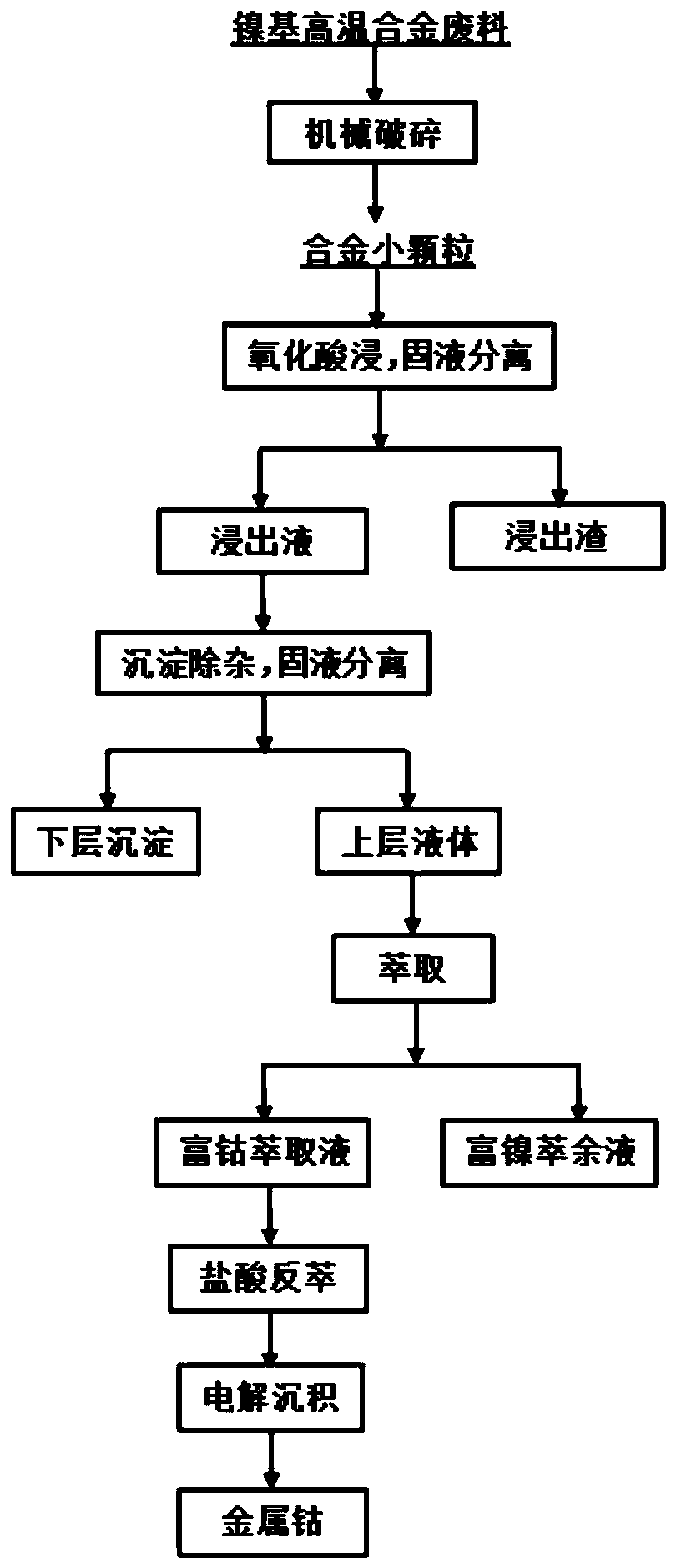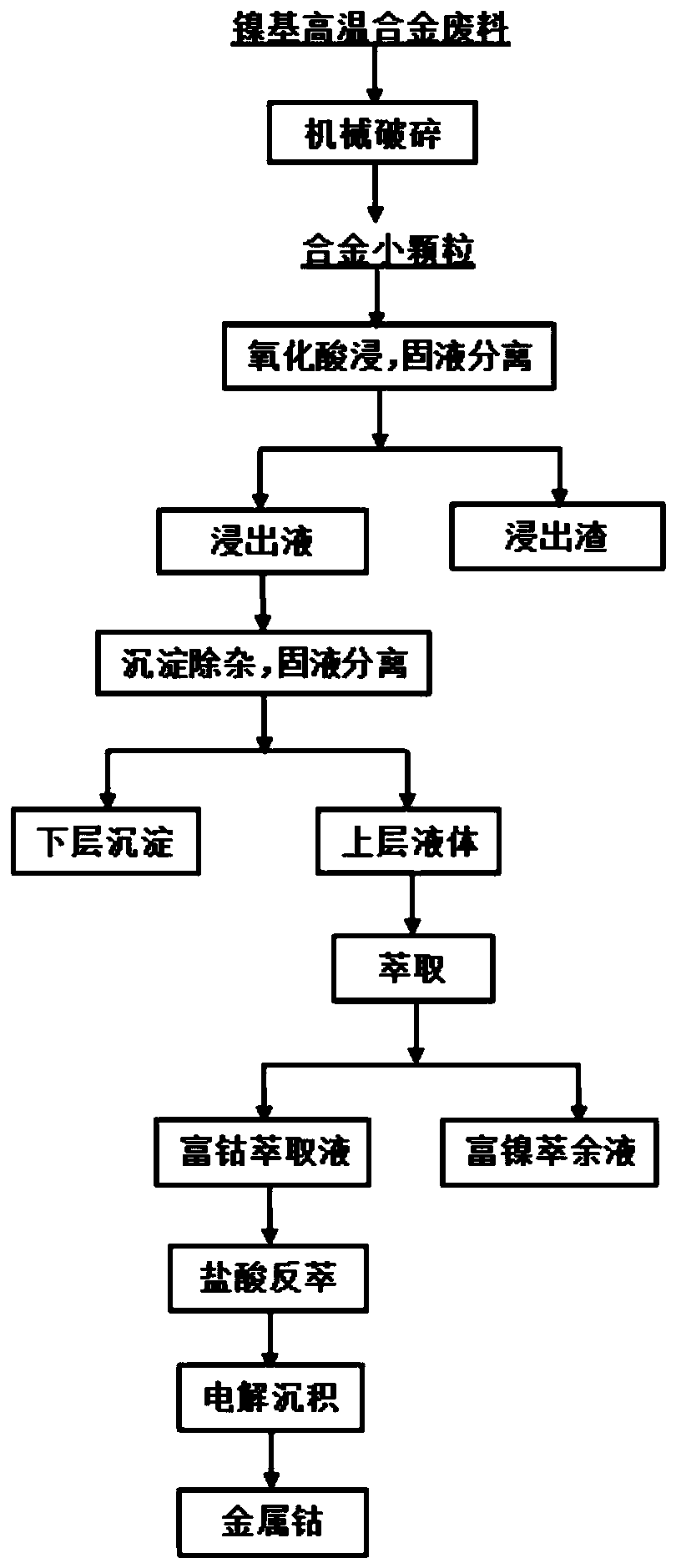Method for recovering cobalt from nickel-based high-temperature alloy cutting waste material
A nickel-based superalloy and scrap technology, applied in the field of cobalt recovery, can solve the problems of difficult large-scale production, high melting point, high energy consumption, etc., and achieve the effect of saving energy consumption, low investment cost and high recovery rate
- Summary
- Abstract
- Description
- Claims
- Application Information
AI Technical Summary
Problems solved by technology
Method used
Image
Examples
Embodiment 1
[0028] The mass fraction of cobalt in the nickel-base superalloy cutting scrap used in this example is 10%.
[0029] (1) breaking nickel-based high-temperature alloy cutting waste into small particles, and the particle size of the alloy particles is 0.1-5mm;
[0030] (2) Place the small alloy particles described in step (1) in the mixed acid of hydrochloric acid and nitric acid for leaching treatment, obtain leachate and leach slag after solid-liquid separation; described hydrochloric acid concentration is 5mol / L, the concentration of nitric acid is 2.5mol / L, the volume of the inorganic acid V=9m, where m is the mass of the alloy powder in g, and the unit of V is mL; the temperature of the leaching treatment is 75°C, and the time of the leaching treatment for 2h;
[0031] (3) Use the alkali solution as a precipitating agent to slowly adjust the pH of the system until the pH value of the reaction system is 5.0, and then perform solid-liquid separation; the temperature of the p...
Embodiment 2
[0036] The mass fraction of cobalt in the nickel-based superalloy cutting scrap used in this example is 12%.
[0037] (1) breaking nickel-based high-temperature alloy cutting waste into small particles, and the particle size of the alloy particles is 0.1-5mm;
[0038] (2) Place the small alloy particles described in step (1) in the mixed acid of hydrochloric acid and nitric acid for leaching treatment, obtain leachate and leach slag after solid-liquid separation; described hydrochloric acid concentration is 6mol / L, the concentration of nitric acid is 2.5mol / L, the volume of the inorganic acid V=8m, where m is the mass of the alloy powder in g, and the unit of V is mL; the temperature of the leaching treatment is 80°C, and the time of the leaching treatment for 2h;
[0039] (3) Use the alkali solution as a precipitating agent to slowly adjust the pH of the system until the pH value of the reaction system is 5.0, and then carry out solid-liquid separation; the temperature of th...
Embodiment 3
[0044] The mass fraction of cobalt in the nickel-based superalloy cutting waste used in this example is 15%.
[0045] (1) breaking nickel-based high-temperature alloy cutting waste into small particles, and the particle size of the alloy particles is 0.1-5mm;
[0046] (2) Place the small alloy particles described in step (1) in the mixed acid of hydrochloric acid and nitric acid for leaching treatment, obtain leachate and leach slag after solid-liquid separation; described hydrochloric acid concentration is 6mol / L, the concentration of nitric acid is 3mol / L, the volume of the inorganic acid V=9m, wherein m is the quality of the alloy powder, the unit is g, and the unit of V is mL; the temperature of the leaching treatment is 80°C, and the time of the leaching treatment is 2h;
[0047](3) Use the alkali solution as a precipitating agent to slowly adjust the pH of the system until the pH value of the reaction system is 5.0, and then carry out solid-liquid separation; the temper...
PUM
| Property | Measurement | Unit |
|---|---|---|
| particle diameter | aaaaa | aaaaa |
Abstract
Description
Claims
Application Information
 Login to View More
Login to View More - R&D
- Intellectual Property
- Life Sciences
- Materials
- Tech Scout
- Unparalleled Data Quality
- Higher Quality Content
- 60% Fewer Hallucinations
Browse by: Latest US Patents, China's latest patents, Technical Efficacy Thesaurus, Application Domain, Technology Topic, Popular Technical Reports.
© 2025 PatSnap. All rights reserved.Legal|Privacy policy|Modern Slavery Act Transparency Statement|Sitemap|About US| Contact US: help@patsnap.com


